Scottish Household Survey 2020 - telephone survey: culture and heritage report
Reports on culture and heritage data from the Scottish Household Survey 2020: telephone survey.
5. Participation in Cultural Activities
Cultural participation is captured in the SHS by asking respondents if they have done at least one activity from the available list in the last 12 months. To maintain consistency with previous years' approaches, cultural participation is reported with reading books for pleasure both included and excluded.
In 2020, 83 per cent of adults in Scotland participated in a cultural activity (Figure 5.1). Reading was by far the most common cultural activity. When reading is excluded, participation was 62 per cent. The next most popular activity was viewing performances online (27 per cent), followed by crafts (23 per cent).
Less than one in five people (17 per cent) had not participated in any cultural activity in the last 12 months.
Percentage of adults, 2020 data (base: 2,790)
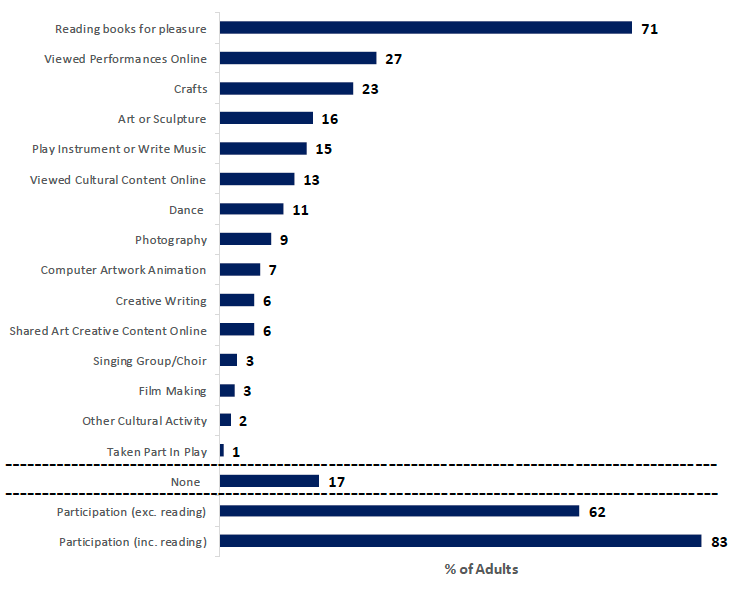
5.1 Frequency of Participation in Cultural Activities
In 2020, the cultural activity that was done the most frequently was reading a book for pleasure (Table 5.1).Of those who read for pleasure, 85 per cent had done so at least once a week, and a further 9 per cent had read less often than once a week, but at least once a month. 66 per cent of those who had played a musical instrument, had done so at least once a week.
Adults participated in cultural activities more frequently than they had attended cultural events or places of culture. However, it is important to recognise that opportunities for participation in some cultural activities may have been adversely affected by Covid-19, particularly those involving participation in group activities.
Percentage of adults, 2020 data
| Adults | At least once a week |
At least once a month |
At least once a year |
Don't know |
Base |
|---|---|---|---|---|---|
| Reading books for pleasure | 85 | 9 | 6 | 0 | 2,090 |
| Play Instrument or Write Music | 66 | 23 | 11 | 0 | 400 |
| Dance | 58 | 15 | 27 | 0 | 250 |
| Photography | 57 | 27 | 16 | 0 | 240 |
| Crafts | 55 | 28 | 16 | 0 | 770 |
| Singing Group/Choir | 54 | 15 | 26 | 5 | 110 |
| Other Cultural Activity | 49 | 20 | 25 | 6 | 50 |
| Art or Sculpture | 47 | 25 | 28 | 0 | 370 |
| Viewed Performances Online | 43 | 25 | 31 | 1 | 710 |
| Viewed Cultural Content Online | 40 | 29 | 31 | 0 | 370 |
| Computer Artwork Animation | 37 | 37 | 23 | 3 | 150 |
| Shared Art Creative Content Online | 37 | 29 | 34 | 0 | 140 |
| Creative Writing | 36 | 36 | 27 | 0 | 150 |
| Film Making | 19 | 38 | 43 | 0 | 60 |
| Taken Part In Play | [u] | [u] | [u] | [u] | 20 |
Note:
1) Sorted by the activity that has the highest occurrence of participation at least once a week.
2) [u] = suppressed value. This is where the base is less than 50 and such data are judged to be insufficiently reliable for publication.
3) Estimates with base numbers close to 50 should also be treated with caution, as even though these estimates have been published, they are subject to high levels of sampling error and have a high degree of uncertainty around them.
5.2 Participation by Gender
In 2020, similarly to attendance patterns, more women than men reported having participated in a cultural activity in the last 12 months. 88 per cent of women had participated in a cultural activity in the last 12 months compared with 78 per cent of men, though this varied by activity (Figure 5.2). When reading is excluded, the difference between women and men was slightly larger (12 percentage points).
Percentage of adults, 2020 data (minimum base: 1,250 [men])
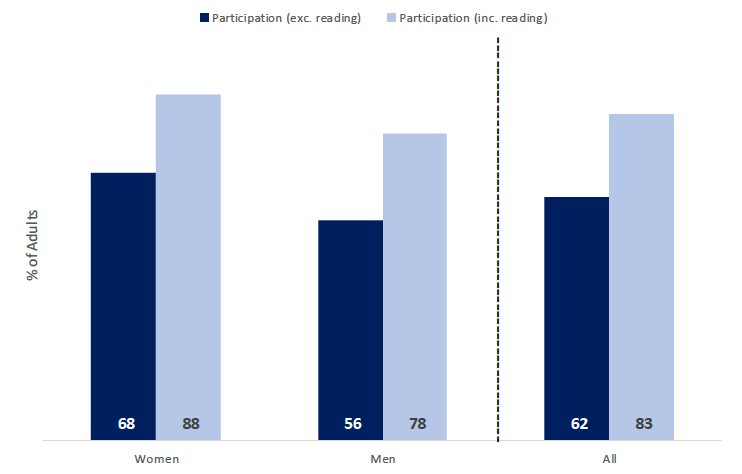
Table 5.2 shows more women than men participated in a number of cultural activities including crafts (35 per cent compared with 10 per cent), reading books for pleasure (78 per cent compared with 64 per cent) and dance (17 per cent compared with 4 per cent).
However, men had higher participation rates than women, in certain cultural activities – including playing a musical instrument or writing music (20 per cent of men and 12 per cent of women) and photography (11 per cent of men and 7 per cent of women).
Percentage of adults, 2020 data
| Adults | Women | Men | All |
|---|---|---|---|
| Reading books for pleasure | 78 | 64 | 71 |
| Dance | 17 | 4 | 11 |
| Play Instrument or Write Music | 12 | 20 | 15 |
| Taken Part In Play | 1 | 1 | 1 |
| Singing Group/Choir | 4 | 2 | 3 |
| Art or Sculpture | 19 | 12 | 16 |
| Photography | 7 | 11 | 9 |
| Film Making | 2 | 4 | 3 |
| Computer Artwork Animation | 5 | 9 | 7 |
| Crafts | 35 | 10 | 23 |
| Creative Writing | 6 | 5 | 6 |
| Viewed Performances Online | 28 | 27 | 27 |
| Viewed Cultural Content Online | 12 | 13 | 13 |
| Shared Art Creative Content Online | 5 | 7 | 6 |
| Other Cultural Activity | 1 | 2 | 2 |
| None | 12 | 22 | 17 |
| Participation (exc. reading) | 68 | 56 | 62 |
| Participation (inc. reading) | 88 | 78 | 83 |
| Base | 1,530 | 1,250 | 2,790 |
Note:
1) Columns add to more than 100 per cent since multiple responses allowed.
2) Gender 'Identified in another way' and 'Refused' responses have not been included in table as all estimates for this sub-group are suppressed because of the small sample size.
5.3 Participation by Age
In contrast to attendance patterns, overall cultural participation was broadly similar for all age groups in 2020.
However, participation in cultural activities was higher among younger age groups when reading was excluded from the measure. 76 per cent of 16 to 24 year olds had participated in cultural activities when reading was excluded compared to 44 per cent of those aged 75 and over (Figure 5.3).
Percentage of adults, 2020 data (minimum base: 110 [16 to 24])
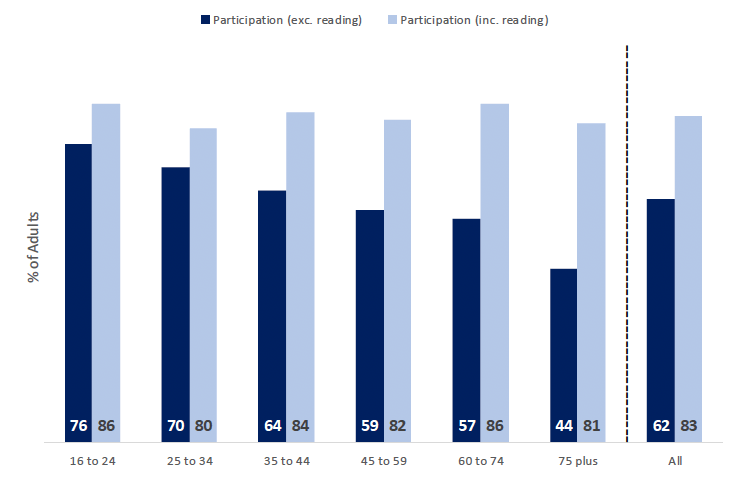
In general older age groups were more likely to read books for pleasure and do craftwork such as knitting, woodwork and pottery than younger age groups. 75 per cent of those aged 75 and over read books for pleasure (compared to 59 per cent for those aged 16 to 24) and 27 per cent did crafts (compared to 9 per cent for those aged 16 to 24).
For other cultural activities, younger adults, particularly those aged 16 to 24, were more likely than older age groups to participate (Table 5.3). The biggest difference can be seen for viewing performances online (36 per cent of 16 to 24 year olds compared to 11 per cent of those aged 75 and over). Adults aged 16 to 24 and 25 to 34 were more likely to do art or sculpture compared to those aged 60 to 74 and 75 and over.
Percentage of adults, 2020 data
| Adults | 16 to 24 | 25 to 34 | 35 to 44 | 45 to 59 | 60 to 74 | 75 plus | All |
|---|---|---|---|---|---|---|---|
| Reading books for pleasure | 59 | 67 | 73 | 73 | 76 | 75 | 71 |
| Dance | 19 | 13 | 12 | 11 | 6 | 4 | 11 |
| Play Instrument or Write Music | 24 | 23 | 16 | 13 | 11 | 6 | 15 |
| Taken Part In Play | 2 | 0 | 1 | 1 | 0 | 0 | 1 |
| Singing Group/Choir | 5 | 1 | 3 | 3 | 2 | 5 | 3 |
| Art or Sculpture | 21 | 27 | 19 | 12 | 10 | 8 | 16 |
| Photography | 11 | 11 | 8 | 10 | 9 | 3 | 9 |
| Film Making | 4 | 7 | 4 | 3 | 1 | 0 | 3 |
| Computer Artwork Animation | 9 | 10 | 8 | 6 | 4 | 3 | 7 |
| Crafts | 9 | 23 | 22 | 22 | 29 | 27 | 23 |
| Creative Writing | 11 | 8 | 6 | 4 | 4 | 3 | 6 |
| Viewed Performances Online | 36 | 37 | 31 | 28 | 20 | 11 | 27 |
| Viewed Cultural Content Online | 8 | 14 | 17 | 14 | 12 | 6 | 13 |
| Shared Art Creative Content Online | 14 | 8 | 6 | 4 | 4 | 2 | 6 |
| Other Cultural Activity | 2 | 1 | 1 | 2 | 2 | 1 | 2 |
| None | 14 | 20 | 16 | 18 | 14 | 19 | 17 |
| Participation (exc. reading) | 76 | 70 | 64 | 59 | 57 | 44 | 62 |
| Participation (inc. reading) | 86 | 80 | 84 | 82 | 86 | 81 | 83 |
| Base | 110 | 250 | 310 | 720 | 1,010 | 400 | 2,790 |
Note:
1) Columns add to more than 100 per cent since multiple responses allowed.
2) Estimates with base numbers close to 50 should also be treated with caution, as even though these estimates have been published, they are subject to high levels of sampling error and have a high degree of uncertainty around them.
5.4 Participation by Highest Level of Qualification
Similarly to cultural attendance, in 2020, participation in cultural activities was highest among adults with a degree or professional qualification (92 per cent) and lowest for those with no qualifications (66 per cent) (Figure 5.4). In general, and similarly to cultural attendance patterns, there was a decrease in participation with level of qualifications. When reading is excluded, the difference in participation between the two groups was even greater (72 per cent for those with a degree or professional qualifications compared with 35 per cent for those with no qualifications).
Percentage of adults, 2020 data (minimum base: 100 [other qualification])
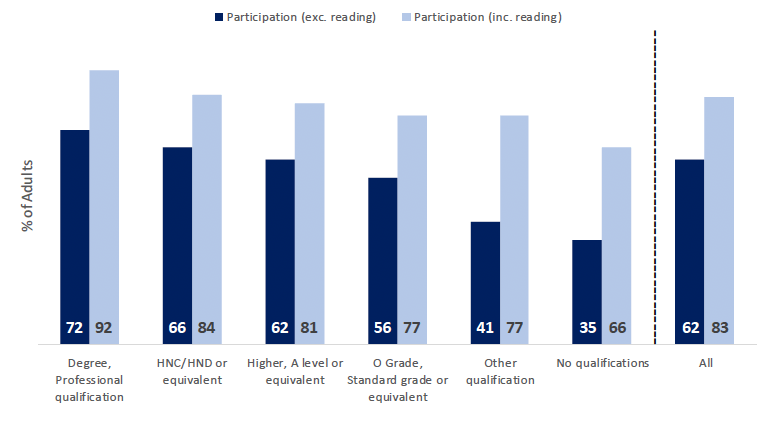
Similar to attendance patterns, larger portions of those with a degree or professional qualification than those with no qualifications participated in most individual cultural activities listed in the question (Table 5.4). In the last 12 months, 84 per cent of those with a degree or professional qualification read books for pleasure compared with 54 per cent of those with no qualifications, and there was a similar difference for viewing performances online (35 per cent compared with 6 per cent).
Percentage of adults, 2020 data
| Adults | Degree, Professional qualification | HNC/HND or equivalent | Higher, A level or equivalent | O Grade, Standard grade or equivalent | Other qualification | No qualifications | All |
|---|---|---|---|---|---|---|---|
| Reading books for pleasure | 84 | 69 | 66 | 58 | 64 | 54 | 71 |
| Dance | 14 | 8 | 11 | 10 | 11 | 2 | 11 |
| Play Instrument or Write Music | 21 | 13 | 14 | 12 | 3 | 7 | 15 |
| Taken Part In Play | 1 | 1 | 1 | 0 | 0 | 0 | 1 |
| Singing Group/Choir | 4 | 1 | 4 | 2 | 3 | 1 | 3 |
| Art or Sculpture | 19 | 15 | 16 | 15 | 12 | 5 | 16 |
| Photography | 14 | 8 | 9 | 4 | 5 | 2 | 9 |
| Film Making | 5 | 4 | 4 | 0 | 0 | 0 | 3 |
| Computer Artwork Animation | 10 | 5 | 6 | 3 | 4 | 2 | 7 |
| Crafts | 28 | 22 | 19 | 18 | 17 | 18 | 23 |
| Creative Writing | 8 | 5 | 7 | 4 | 4 | 1 | 6 |
| Viewed Performances Online | 35 | 30 | 30 | 22 | 12 | 6 | 27 |
| Viewed Cultural Content Online | 20 | 13 | 9 | 6 | 4 | 3 | 13 |
| Shared Art Creative Content Online | 8 | 6 | 8 | 2 | 1 | 1 | 6 |
| Other Cultural Activity | 2 | 1 | 2 | 3 | 0 | 1 | 2 |
| None | 8 | 16 | 19 | 23 | 23 | 34 | 17 |
| Participation (exc. reading) | 72 | 66 | 62 | 56 | 41 | 35 | 62 |
| Participation (inc. reading) | 92 | 84 | 81 | 77 | 77 | 66 | 83 |
| Base | 1,170 | 330 | 420 | 370 | 100 | 380 | 2,790 |
Note:
1) Columns may not add to 100 per cent as multiple responses allowed.
2) Estimates with base numbers close to 50 should also be treated with caution, as even though these estimates have been published, they are subject to high levels of sampling error and have a high degree of uncertainty around them.
3) 'Qualifications not known' responses have not been included in table as all estimates for this sub-group are suppressed because of the small sample size.
5.5 Participation by Scottish Index of Multiple Deprivation
In 2020, a larger portion of those in the 'least deprived' areas participated in cultural activities (89 per cent) compared with those living in the most deprived areas (75 per cent) (as measured by the Scottish Index of Multiple Deprivation (SIMD, 2020)) (Figure 5.5). This is consistent with the differences observed for cultural attendance. When reading is excluded, the pattern was similar with 49 per cent of those in the most deprived areas and 68 per cent of those in the least deprived areas of Scotland having participated in a cultural activity.
Percentage of adults, 2020 data (minimum base: 340 [most deprived area])
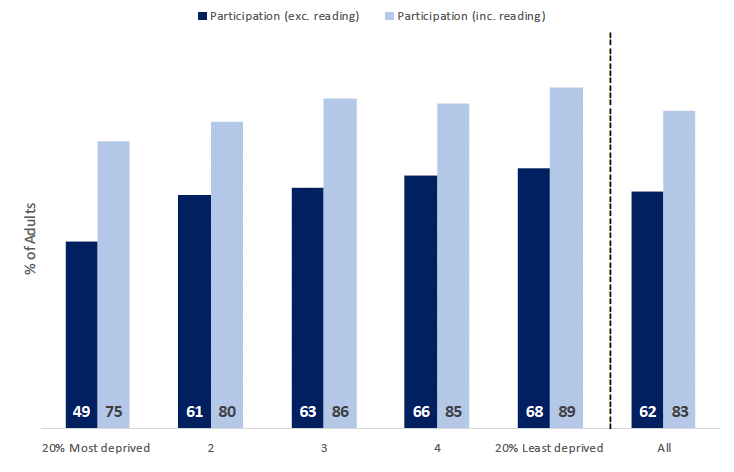
Participation for some cultural activities, such as reading, playing an instrument or writing music and viewing cultural performances online, was higher for adults living in the least deprived areas compared to those in the most deprived areas (Table 5.5). The most marked differences between those living in the 20 per cent least deprived areas and those living in the 20 per cent most deprived areas were reading a book for pleasure (78 per cent and 64 per cent respectively) and viewing performances online (30 per cent and 20 per cent respectively).
However, participation was similar between those living in the least and most deprived areas, in certain activities such as art and sculpture, photography, film making, computer artwork animation, dancing and crafts.
Percentage of adults, 2020 data
| Adults | 20% Most deprived | 2 | 3 | 4 | 20% Least deprived | All |
|---|---|---|---|---|---|---|
| Reading books for pleasure | 64 | 67 | 73 | 72 | 78 | 71 |
| Dance | 9 | 10 | 11 | 11 | 12 | 11 |
| Play Instrument or Write Music | 9 | 12 | 18 | 19 | 17 | 15 |
| Taken Part In Play | 1 | 0 | 0 | 1 | 1 | 1 |
| Singing Group/Choir | 2 | 4 | 3 | 4 | 2 | 3 |
| Art or Sculpture | 14 | 13 | 17 | 18 | 15 | 16 |
| Photography | 7 | 8 | 11 | 11 | 7 | 9 |
| Film Making | 2 | 2 | 4 | 4 | 3 | 3 |
| Computer Artwork Animation | 7 | 5 | 8 | 5 | 7 | 7 |
| Crafts | 21 | 22 | 22 | 24 | 24 | 23 |
| Creative Writing | 8 | 4 | 6 | 6 | 3 | 6 |
| Viewed Performances Online | 20 | 25 | 28 | 33 | 30 | 27 |
| Viewed Cultural Content Online | 8 | 13 | 12 | 15 | 14 | 13 |
| Shared Art Creative Content Online | 5 | 6 | 10 | 5 | 5 | 6 |
| Other Cultural Activity | 1 | 3 | 2 | 1 | 1 | 2 |
| None | 25 | 20 | 14 | 15 | 11 | 17 |
| Participation (exc. reading) | 49 | 61 | 63 | 66 | 68 | 62 |
| Participation (inc. reading) | 75 | 80 | 86 | 85 | 89 | 83 |
| Base | 340 | 430 | 660 | 750 | 620 | 2,790 |
Note:
1) Columns may not add to 100 per cent as multiple responses allowed.
5.6 Participation by Net Annual Household Income
In 2020, cultural participation was broadly similar for those with a net annual household income above £30,000 and those with a net annual household income below £10,000 (Figure 5.6). However, when reading is excluded, participation was notably lower for those with a net annual household income of up to £10,000 (50 per cent) compared to those with a net annual income of above £30,000 (65 per cent).
Percentage of adults, 2020 data (minimum base: 190 [£0 - £10,000])
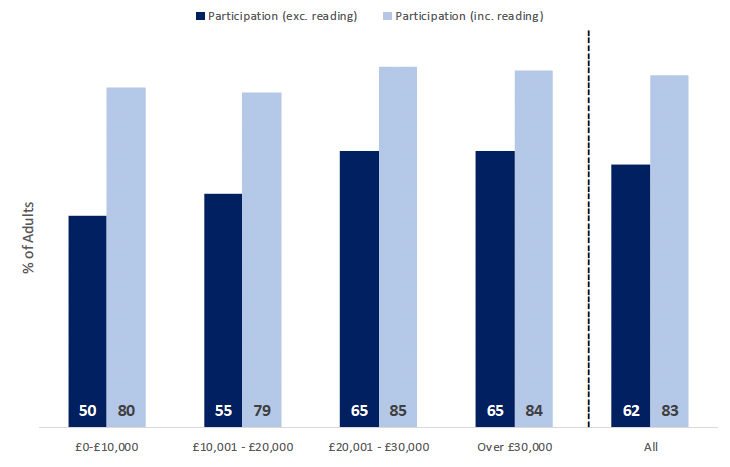
Across certain activities, participation was highest for adults with a net annual household income of over £30,000 (Table 5.6). Notable differences between those with net annual household income above £30,000 and those with a net annual household income of up to £10,000 can be found in activities such as viewing cultural content online, dancing and photography.
Percentage of adults, 2020 data
| Adults | £0-£10,000 | £10,001 - £20,000 | £20,001 - £30,000 | Over £30,000 | All |
|---|---|---|---|---|---|
| Reading books for pleasure | 67 | 68 | 70 | 73 | 71 |
| Dance | 4 | 10 | 12 | 11 | 11 |
| Play Instrument or Write Music | 13 | 11 | 16 | 16 | 15 |
| Taken Part In Play | 0 | 0 | 1 | 1 | 1 |
| Singing Group/Choir | 4 | 2 | 3 | 3 | 3 |
| Art or Sculpture | 12 | 15 | 17 | 16 | 16 |
| Photography | 3 | 8 | 10 | 10 | 9 |
| Film Making | 5 | 1 | 3 | 4 | 3 |
| Computer Artwork Animation | 5 | 3 | 8 | 8 | 7 |
| Crafts | 24 | 26 | 28 | 21 | 23 |
| Creative Writing | 11 | 3 | 6 | 6 | 6 |
| Viewed Performances Online | 23 | 19 | 32 | 30 | 27 |
| Viewed Cultural Content Online | 7 | 6 | 14 | 15 | 13 |
| Shared Art Creative Content Online | 8 | 4 | 6 | 7 | 6 |
| Other Cultural Activity | 1 | 1 | 3 | 2 | 2 |
| None | 20 | 21 | 15 | 16 | 17 |
| Participation (exc. reading) | 50 | 55 | 65 | 65 | 62 |
| Participation (inc. reading) | 80 | 79 | 85 | 84 | 83 |
| Base | 190 | 630 | 600 | 1,290 | 2,790 |
Note:
1) Columns may not add to more than 100 per cent as multiple responses allowed.
2) 'Unknown or low' incomes have been excluded from this table.
5.7 Participation by Disability
In the SHS, 'disability' is defined as the presence of any physical or mental health condition or illness that is expected to last 12 months or more, and that reduces the person's ability to carry out day-to-day activities.[10]In 2020, cultural participation between adults that reported having such a condition and those that reported having no disability is broadly similar(Figure 5.7). The difference is notably greater when reading is excluded, with participation for those reporting a disability being 53 per cent and, for those with no disability, it was 65 per cent.
Percentage of adults, 2020 data (minimum base: 720 [disabled])
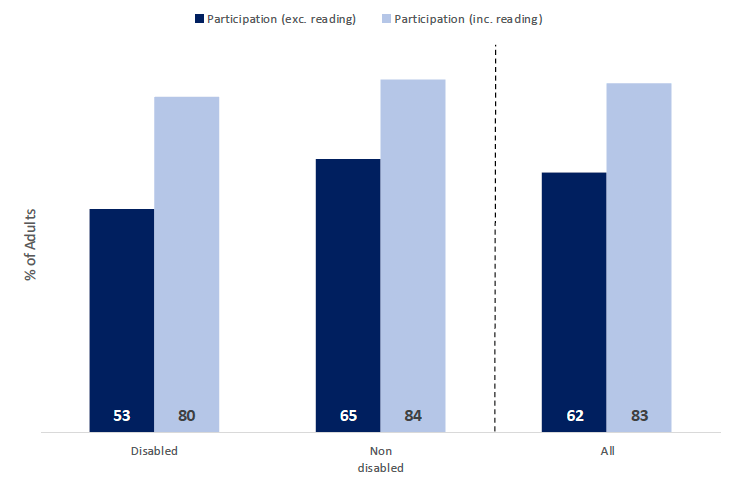
The most marked difference can be seen for viewing performances online. 29 per cent of those with no disability had viewed performances online in the last 12 months compared with 20 per cent of those with a disability. 73 per cent of those with no disability had read in the last 12 months, compared 66 per cent of those with a disability.
Participation is more similar across certain activities. For example, participation in computer artwork animation, film making, singing in a group/choir, art or sculpture, crafts, and sharing artistic or creative content that you have created yourself is similar for both groups (Table 5.7).
Percentage of adults, 2020 data
| Adults | Disabled | Non-disabled | All |
|---|---|---|---|
| Reading books for pleasure | 66 | 73 | 71 |
| Dance | 6 | 12 | 11 |
| Play Instrument or Write Music | 12 | 16 | 15 |
| Taken Part In Play | 0 | 1 | 1 |
| Singing Group/Choir | 3 | 3 | 3 |
| Art or Sculpture | 15 | 16 | 16 |
| Photography | 7 | 10 | 9 |
| Film Making | 3 | 3 | 3 |
| Computer Artwork Animation | 7 | 7 | 7 |
| Crafts | 22 | 23 | 23 |
| Creative Writing | 4 | 6 | 6 |
| Viewed Performances Online | 20 | 29 | 27 |
| Viewed Cultural Content Online | 10 | 13 | 13 |
| Shared Art Creative Content Online | 5 | 6 | 6 |
| Other Cultural Activity | 1 | 2 | 2 |
| None | 20 | 16 | 17 |
| Participation (exc. reading) | 53 | 65 | 62 |
| Participation (inc. reading) | 80 | 84 | 83 |
| Base | 720 | 2,060 | 2,790 |
Note:
1) Columns may not add to 100 per cent as multiple responses allowed.
2) A disability is defined in the SHS as a long-term limiting physical or mental health condition.
3) 'Don't Know' and 'Refused' responses have not been included in table as all estimates for this sub-group are suppressed because of the small sample size.
5.8 Participation by Ethnicity
Compared to the average, cultural participation (including reading) was higher for 'White: Other' adults (92 per cent) in 2020.Cultural participation between minority ethnic adults (80 per cent) was broadly similar to 'White: Scottish' adults (82 per cent) (Table 5.8). However, there was a notable difference between these groups for viewing cultural content online, with 24 per cent of minority ethnic adults reporting that they viewed cultural content online in the last 12 months whereas only 10 per cent of 'White: Scottish' adults reported doing so.
Percentage of adults, 2020 data
| Adults | White: Scottish |
White: Other British |
White: Other |
Minority Ethnic Groups |
All |
|---|---|---|---|---|---|
| Reading books for pleasure | 69 | 80 | 86 | 60 | 71 |
| Dance | 10 | 10 | 17 | 18 | 11 |
| Play Instrument or Write Music | 14 | 17 | 22 | 21 | 15 |
| Taken Part In Play | 1 | 1 | 3 | 2 | 1 |
| Singing Group/Choir | 3 | 4 | 4 | 3 | 3 |
| Art or Sculpture | 14 | 20 | 20 | 17 | 16 |
| Photography | 8 | 12 | 17 | 11 | 9 |
| Film Making | 3 | 4 | 5 | 5 | 3 |
| Computer Artwork Animation | 6 | 7 | 7 | 10 | 7 |
| Crafts | 22 | 27 | 30 | 15 | 23 |
| Creative Writing | 5 | 8 | 9 | 10 | 6 |
| Viewed Performances Online | 27 | 28 | 39 | 21 | 27 |
| Viewed Cultural Content Online | 10 | 20 | 23 | 24 | 13 |
| Shared Art Creative Content Online | 5 | 10 | 9 | 11 | 6 |
| Other Cultural Activity | 1 | 2 | 1 | 10 | 2 |
| None | 18 | 13 | 8 | 20 | 17 |
| Participation (exc. reading) | 60 | 67 | 72 | 64 | 62 |
| Participation (inc. reading) | 82 | 87 | 92 | 80 | 83 |
| Base | 2,100 | 490 | 120 | 70 | 2,790 |
Note:
1) Columns may not add to 100 per cent since multiple responses were allowed.
2) Estimates with base numbers close to 50 should also be treated with caution, as even though these estimates have been published, they are subject to high levels of sampling error and have a high degree of uncertainty around them.
3) For the purposes of the analysis presented in this table, 'White: Other' includes Irish, Gypsy/Traveller, Polish and other white ethnic groups and 'Minority ethnic groups' includes mixed or multiple, Asian, African, Caribbean or Black, Arab or any other ethnic groups
5.9 Participation by Sexual Orientation
In 2020, cultural participation (including reading) was similar between adults of different sexual orientation, with83 per cent of both heterosexual / straight adults and gay, lesbian or bisexual adults having participated in a cultural activity in the 12 last months (Table 5.9).
Across each activity, no significant difference for cultural participation was observed between heterosexual / straight adults and gay, lesbian or bisexual adults.
Percentage of adults, 2020 data
| Adults | Heterosexual / Straight | Gay, Lesbian or Bisexual |
All |
|---|---|---|---|
| Reading books for pleasure | 71 | 80 | 71 |
| Dance | 10 | 13 | 11 |
| Play Instrument or Write Music | 16 | 14 | 15 |
| Taken Part In Play | 1 | 0 | 1 |
| Singing Group/Choir | 3 | 3 | 3 |
| Art or Sculpture | 15 | 27 | 16 |
| Photography | 9 | 16 | 9 |
| Film Making | 3 | 11 | 3 |
| Computer Artwork Animation | 6 | 13 | 7 |
| Crafts | 23 | 23 | 23 |
| Creative Writing | 6 | 9 | 6 |
| Viewed Performances Online | 27 | 40 | 27 |
| Viewed Cultural Content Online | 13 | 8 | 13 |
| Shared Art Creative Content Online | 6 | 14 | 6 |
| Other Cultural Activity | 2 | 0 | 2 |
| None | 17 | 17 | 17 |
| Participation (exc. reading) | 62 | 70 | 62 |
| Participation (inc. reading) | 83 | 83 | 83 |
| Base | 2,710 | 60 | 2,790 |
Note:
1) Columns may not add to 100 per cent since multiple responses were allowed.
2) Estimates with base numbers close to 50 should also be treated with caution, as even though these estimates have been published, they are subject to high levels of sampling error and have a high degree of uncertainty around them.
3) 'Other' and 'Refused / prefer not to say' responses have not been included in table as all estimates for this sub-group are suppressed because of the small sample size.
5.10 Participation by Religion
In 2020, cultural participation (including reading) across different religious groups was broadly similar, with the only notable difference observed between adults who said their religion was 'Other Christian' (88 per cent), and for those who said 'Roman Catholic' (79 per cent) (Table 5.10).
Compared to the average, adults of 'Another religion' were less likely to have viewed performances online in the last 12 months (13 per cent compared to 27 per cent).
Percentage of adults, 2020 data
| Adults | None | Church of Scotland |
Roman Catholic |
Other Christian |
Another religion |
All |
|---|---|---|---|---|---|---|
| Reading books for pleasure | 71 | 72 | 67 | 76 | 76 | 71 |
| Dance | 11 | 7 | 12 | 14 | 7 | 11 |
| Play Instrument or Write Music | 17 | 12 | 13 | 21 | 9 | 15 |
| Taken Part In Play | 1 | 1 | 1 | 1 | 3 | 1 |
| Singing Group/Choir | 3 | 5 | 2 | 5 | 0 | 3 |
| Art or Sculpture | 19 | 9 | 11 | 17 | 11 | 16 |
| Photography | 11 | 6 | 6 | 9 | 11 | 9 |
| Film Making | 4 | 2 | 1 | 3 | 5 | 3 |
| Computer Artwork Animation | 8 | 5 | 1 | 8 | 11 | 7 |
| Crafts | 23 | 27 | 16 | 24 | 23 | 23 |
| Creative Writing | 6 | 4 | 6 | 5 | 17 | 6 |
| Viewed Performances Online | 32 | 23 | 21 | 24 | 13 | 27 |
| Viewed Cultural Content Online | 13 | 9 | 12 | 16 | 16 | 13 |
| Shared Art Creative Content Online | 8 | 3 | 3 | 4 | 14 | 6 |
| Other Cultural Activity | 1 | 2 | 3 | 1 | 8 | 2 |
| None | 17 | 17 | 21 | 12 | 15 | 17 |
| Participation (exc. reading) | 65 | 57 | 54 | 67 | 57 | 62 |
| Participation (inc. reading) | 83 | 83 | 79 | 88 | 85 | 83 |
| Base | 1,360 | 740 | 300 | 320 | 60 | 2,790 |
Note:
1) Columns may not add to 100 per cent since multiple responses were allowed.
2) Estimates with base numbers close to 50 should also be treated with caution, as even though these estimates have been published, they are subject to high levels of sampling error and have a high degree of uncertainty around them.
5.11 Participation by Marital Status
In 2020, cultural participation (including reading) across various marital statuses is broadly similar. However, when reading is excluded, single adults were observed to have the highest cultural participation (70 per cent) compared to the average (62 per cent) and other groups. They were also notably more likely to take part in activities such as art or sculpture or play instrument or write music than the other groups (Table 5.11).
Percentage of adults, 2020 data
| Adults | Single | Married / Civil partnership |
Divorced / Separated | Widowed / Bereaved civil partner | All |
|---|---|---|---|---|---|
| Reading books for pleasure | 68 | 72 | 76 | 76 | 71 |
| Dance | 14 | 8 | 11 | 5 | 11 |
| Play Instrument or Write Music | 21 | 13 | 11 | 8 | 15 |
| Taken Part In Play | 1 | 1 | 0 | 0 | 1 |
| Singing Group/Choir | 3 | 3 | 3 | 5 | 3 |
| Art or Sculpture | 22 | 12 | 11 | 10 | 16 |
| Photography | 11 | 8 | 11 | 3 | 9 |
| Film Making | 4 | 3 | 0 | 0 | 3 |
| Computer Artwork Animation | 8 | 6 | 4 | 1 | 7 |
| Crafts | 18 | 25 | 25 | 31 | 23 |
| Creative Writing | 8 | 4 | 5 | 4 | 6 |
| Viewed Performances Online | 35 | 23 | 30 | 10 | 27 |
| Viewed Cultural Content Online | 15 | 11 | 16 | 5 | 13 |
| Shared Art Creative Content Online | 9 | 5 | 4 | 2 | 6 |
| Other Cultural Activity | 2 | 2 | 1 | 2 | 2 |
| None | 15 | 18 | 16 | 17 | 17 |
| Participation (exc. reading) | 70 | 58 | 60 | 51 | 62 |
| Participation (inc. reading) | 85 | 82 | 84 | 83 | 83 |
| Base | 730 | 1,390 | 350 | 310 | 2,790 |
Note:
1) Columns may not add to 100 per cent since multiple responses were allowed.
5.12 Participation by Economic Status
In 2020, cultural participation (including reading) between various economic statuses is broadly similar. However, when reading is excluded, adults in employment had a larger level of cultural participation (64 per cent) compared to adults permanently retired from work (51 per cent) (Table 5.12)
For most cultural activities, adults in employment had higher levels of participation compared to adults who are permanently retired. Employed adults were more likely to: view performances online; play an instrument or write music; do art or sculpture; dance; do computer artwork animation; try photography or film making; view cultural content online or share art or creative content online that they have created themselves. However, retired adults were more likely to have done crafts in the last 12 months compared to employed adults and those of 'Other' economic status.
Percentage of adults, 2020 data
| Adults | In employment |
Permanently retired from work |
Other | All |
|---|---|---|---|---|
| Reading books for pleasure | 72 | 76 | 62 | 71 |
| Dance | 11 | 5 | 16 | 11 |
| Play Instrument or Write Music | 18 | 9 | 17 | 15 |
| Taken Part In Play | 1 | 0 | 0 | 1 |
| Singing Group/Choir | 3 | 4 | 3 | 3 |
| Art or Sculpture | 17 | 8 | 20 | 16 |
| Photography | 12 | 7 | 5 | 9 |
| Film Making | 5 | 0 | 2 | 3 |
| Computer Artwork Animation | 9 | 3 | 4 | 7 |
| Crafts | 22 | 29 | 16 | 23 |
| Creative Writing | 6 | 4 | 8 | 6 |
| Viewed Performances Online | 30 | 17 | 34 | 27 |
| Viewed Cultural Content Online | 14 | 10 | 11 | 13 |
| Shared Art Creative Content Online | 7 | 3 | 9 | 6 |
| Other Cultural Activity | 1 | 1 | 3 | 2 |
| None | 17 | 16 | 17 | 17 |
| Participation (exc. reading) | 64 | 51 | 69 | 62 |
| Participation (inc. reading) | 83 | 84 | 83 | 83 |
| Base | 1,330 | 1,130 | 320 | 2,790 |
Note:
1) Columns may not add to 100 per cent since multiple responses were allowed.
2) 'Other' includes adults that are unemployed or inactive.
5.13 Participation by two-fold Urban Rural Classification
In 2020, participation in cultural activities (including reading) was higher among adults living in rural areas (87 per cent) and lower for those living in urban areas (82 per cent) (Table 5.13). However, across most activities, participation is broadly similar, with the most marked difference being for crafts, with 28 per cent of adults from rural areas taking part in crafts compared to 22 per cent for those living in urban areas.
Percentage of adults, 2020 data
| Adults | Urban areas |
Rural areas |
All |
|---|---|---|---|
| Reading books for pleasure | 70 | 74 | 71 |
| Dance | 11 | 10 | 11 |
| Play Instrument or Write Music | 15 | 17 | 15 |
| Taken Part In Play | 1 | 1 | 1 |
| Singing Group/Choir | 3 | 3 | 3 |
| Art or Sculpture | 16 | 13 | 16 |
| Photography | 9 | 12 | 9 |
| Film Making | 3 | 1 | 3 |
| Computer Artwork Animation | 7 | 4 | 7 |
| Crafts | 22 | 28 | 23 |
| Creative Writing | 6 | 5 | 6 |
| Viewed Performances Online | 27 | 28 | 27 |
| Viewed Cultural Content Online | 12 | 14 | 13 |
| Shared Art Creative Content Online | 6 | 7 | 6 |
| Other Cultural Activity | 2 | 1 | 2 |
| None | 18 | 13 | 17 |
| Participation (exc. reading) | 61 | 65 | 62 |
| Participation (inc. reading) | 82 | 87 | 83 |
| Base | 2,020 | 770 | 2,790 |
Note:
1) Columns may not add to 100 per cent since multiple responses were allowed.
Contact
Email: andrew.o'neil@gov.scot
There is a problem
Thanks for your feedback